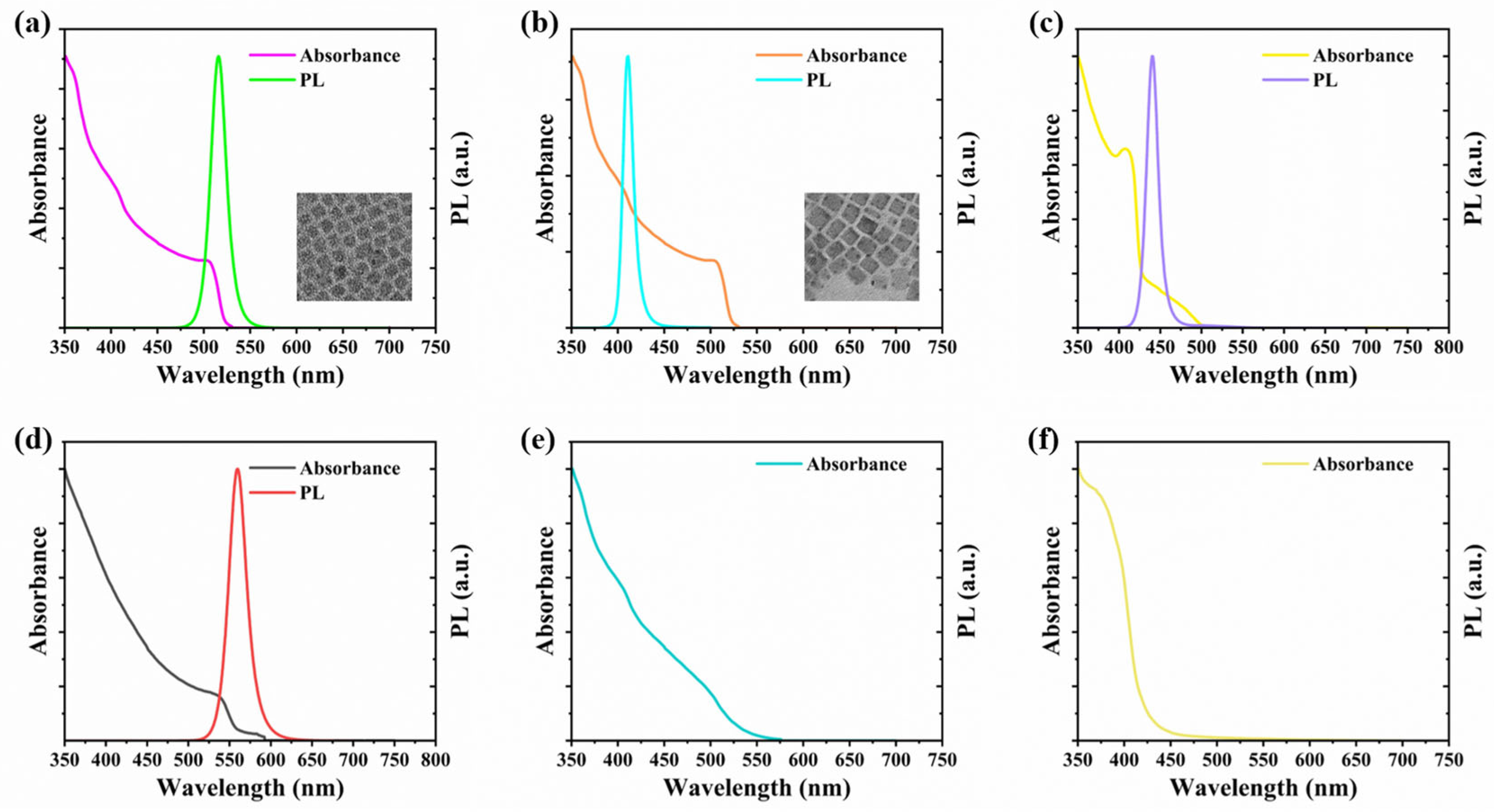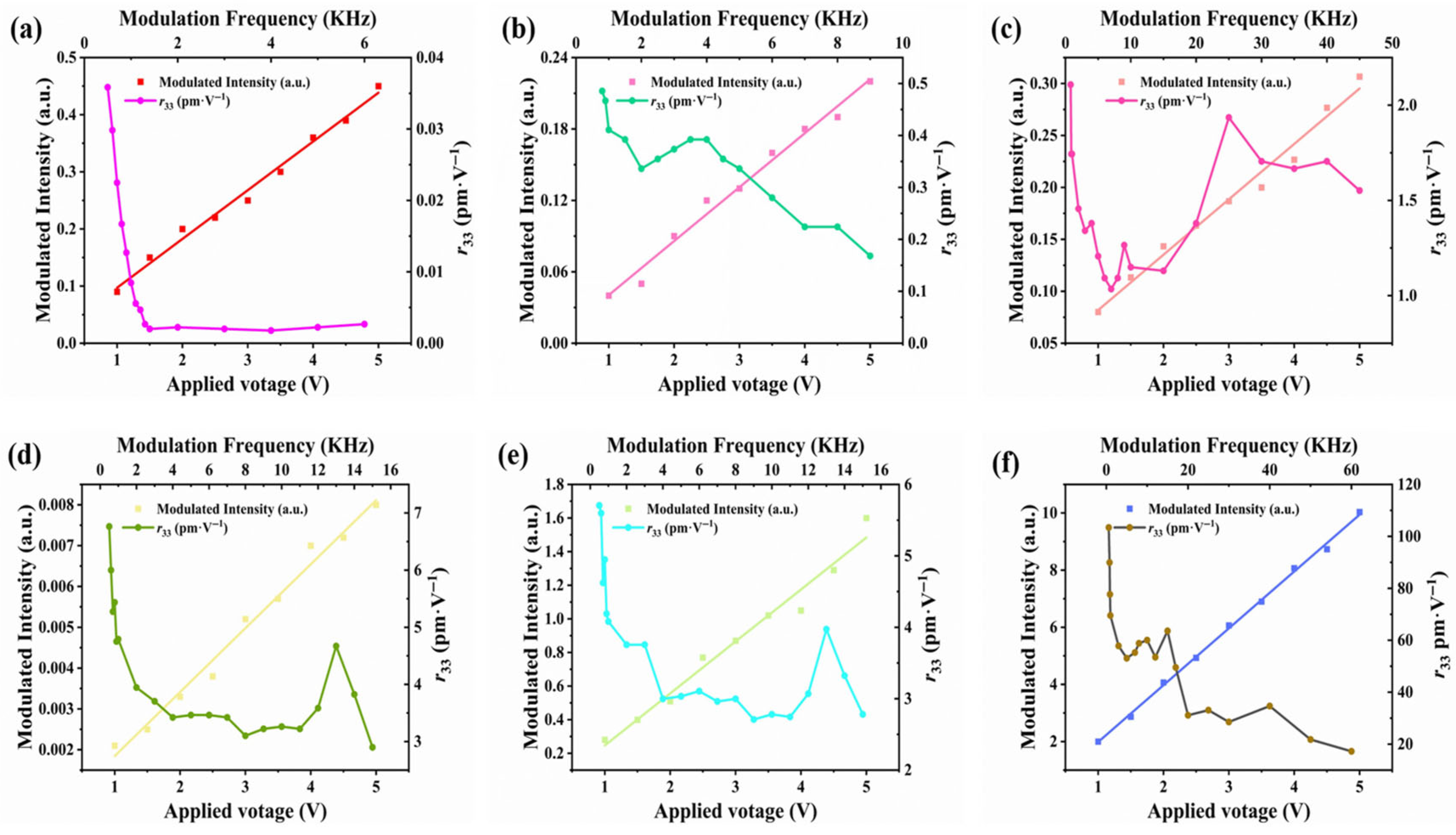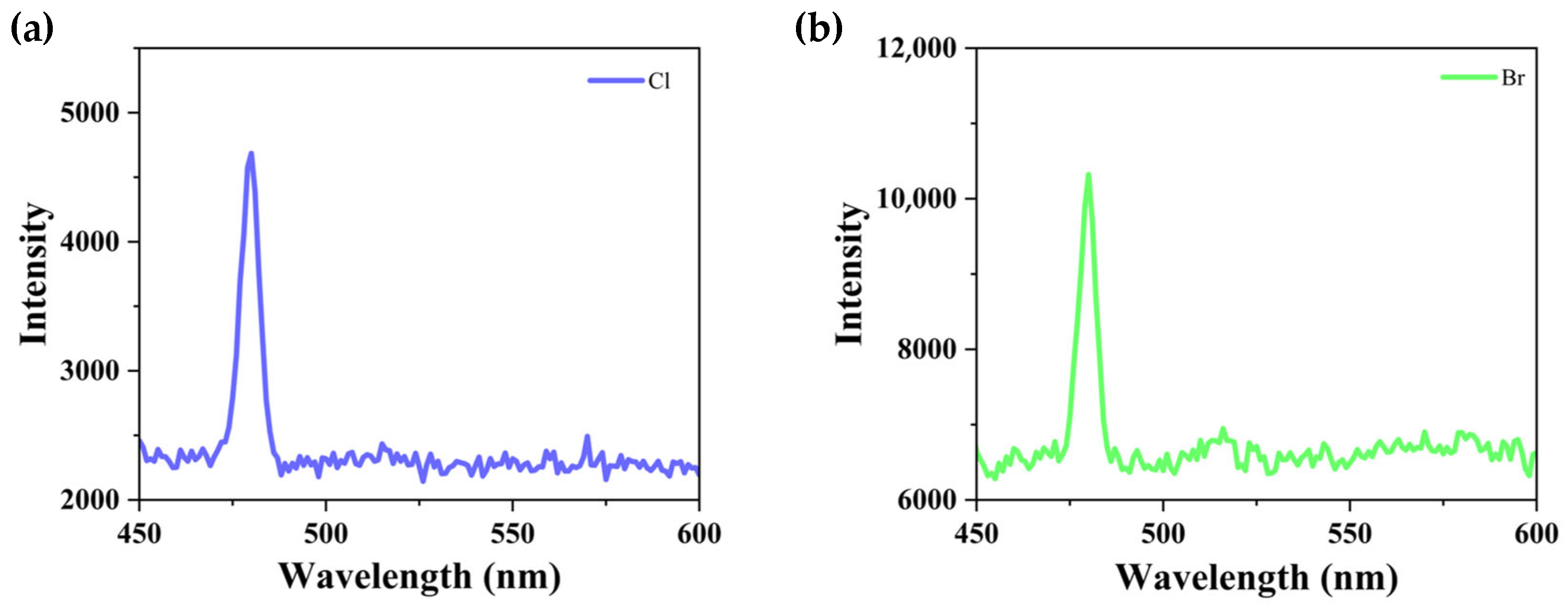Linear Electro-Optic Modulation in Electrophoretically Deposited Perovskite Nanocrystal Films
Abstract
1. Introduction
2. Results
3. Conclusions
Supplementary Materials
Author Contributions
Funding
Data Availability Statement
Conflicts of Interest
References
- Protesescu, L.; Yakunin, S.; Bodnarchuk, M.I.; Krieg, F.; Caputo, R.; Hendon, C.H.; Yang, R.X.; Walsh, A.; Kovalenko, M.V. Nanocrystals of Cesium Lead Halide Perovskites (CsPbX3, X = Cl, Br, and I): Novel Optoelectronic Materials Showing Bright Emission with Wide Color Gamut. Nano Lett. 2015, 15, 3692–3696. [Google Scholar] [CrossRef]
- Arumugam, G.M.; Karunakaran, S.K.; Galian, R.E.; Pérez-Prieto, J. Recent progress in lanthanide-doped inorganic perovskite nanocrystals and Nanoheterostructures: A future vision of bioimaging. Nanomaterials 2022, 12, 2130. [Google Scholar] [CrossRef] [PubMed]
- Kannan, P.K.; Anandkumar, M.; Bhavani, G. Chalcogenide perovskites—Challenges, status, and future prospects. J. Semicond. 2024, 45, 111801. [Google Scholar] [CrossRef]
- Mu, Y.; He, Z.; Wang, K.; Pi, X.; Zhou, S. Recent progress and future prospects on halide perovskite nanocrystals for optoelectronics and beyond. iScience 2022, 25, 105371. [Google Scholar] [CrossRef] [PubMed]
- Swarnkar, A.; Marshall, A.R.; Sanehira, E.M.; Chernomordik, B.D.; Moore, D.T.; Christians, J.A.; Chakrabarti, T.; Luther, J.M. Quantum dot–induced phase stabilization of α-CsPbI3 perovskite for high-efficiency photovoltaics. Science 2016, 354, 92–95. [Google Scholar] [CrossRef]
- Ge, K.; Liang, C. Improved efficiency and stability of inverse perovskite solar cells via passivation cleaning. J. Semicond. 2024, 45, 102801. [Google Scholar] [CrossRef]
- Butt, M.A. Emerging Trends in Thermo-Optic and Electro-Optic Materials for Tunable Photonic Devices. Materials 2025, 18, 2782. [Google Scholar] [CrossRef]
- Gao, Y.; Meshkat, S.; Johnston, A.; Zheng, C.; Walters, G.; Feng, Q.; Wang, X.; Sun, M.-J.; Najarian, A.M.; Xue, D.; et al. Electro-Optic Modulation Using Metal-Free Perovskites. ACS Appl. Mater. Interfaces 2021, 13, 19042–19047. [Google Scholar] [CrossRef]
- Morrow, D.J.; Hautzinger, M.P.; Lafayette, D.P., II; Scheeler, J.M.; Dang, L.; Leng, M.; Kohler, D.D.; Wheaton, A.M.; Fu, Y.; Guzei, I.A.; et al. Disentangling Second Harmonic Generation from Multiphoton Photoluminescence in Halide Perovskites using Multidimensional Harmonic Generation. J. Phys. Chem. Lett. 2020, 11, 6551–6559. [Google Scholar] [CrossRef]
- Levine, I.; Nayak, P.K.; Wang, J.T.-W.; Sakai, N.; Van Reenen, S.; Brenner, T.M.; Mukhopadhyay, S.; Snaith, H.J.; Hodes, G.; Cahen, D. Interface-Dependent Ion Migration/Accumulation Controls Hysteresis in MAPbI3 Solar Cells. J. Phys. Chem. C 2016, 120, 16399–16411. [Google Scholar] [CrossRef]
- Wang, H.; Chen, L.; Wu, Y.; Li, S.; Zhu, G.; Liao, W.; Zou, Y.; Chu, T.; Fu, Q.; Dong, W. Advancing inorganic electro-optical materials for 5 G communications: From fundamental mechanisms to future perspectives. Light Sci. Appl. 2025, 14, 190. [Google Scholar] [CrossRef] [PubMed]
- Dickerson, J.H.; Boccaccini, A.R. Electrophoretic Deposition of Nanomaterials; Springer: Cham, Switzerland, 2011; pp. 138–145. [Google Scholar] [CrossRef]
- Gao, Y.; Walters, G.; Qin, Y.; Chen, B.; Min, Y.; Seifitokaldani, A.; Sun, B.; Todorovic, P.; Saidaminov, M.I.; Lough, A.; et al. Electro-Optic Modulation in Hybrid Metal Halide Perovskites. Adv. Mater. 2019, 31, 1808336. [Google Scholar] [CrossRef] [PubMed]
- He, S. Thin coating technologies and applications in high-temperature solid oxide fuel cells. In Functional Thin Films Technology; CRC Press: Boca Raton, FL, USA, 2021; pp. 83–126. [Google Scholar] [CrossRef]
- Wang, S.; Zhu, T.; Sabatini, R.; Najarian, A.M.; Imran, M.; Zhao, R.; Xia, P.; Zeng, L.; Hoogland, S.; Seferos, D.S. Engineering electro-optic BaTiO3 nanocrystals via efficient doping. Adv. Mater. 2022, 34, 2207261. [Google Scholar] [CrossRef]
- Guo, X.; Ji, X.; Yao, B.; Tan, T.; Chu, A.; Westreich, O.; Dutt, A.; Wong, C.; Su, Y. Ultra-wideband integrated photonic devices on silicon platform: From visible to mid-IR. Nanophotonics 2023, 12, 167–196. [Google Scholar] [CrossRef]
- Meng, R.; Wu, G.; Zhou, J.; Zhou, H.; Fang, H.; Loi, M.A.; Zhang, Y. Understanding the Impact of Bismuth Heterovalent Doping on the Structural and Photophysical Properties of CH3NH3PbBr3 Halide Perovskite Crystals with Near-IR Photoluminescence. Chem. Eur. J. 2019, 25, 5480–5488. [Google Scholar] [CrossRef]
- Mamgain, S.; Yella, A. Dynamics of interfacial charge transfer between CsPbBr3 perovskite nanocrystals and molecular acceptors for photodetection application. Nanotechnology 2024, 35, 165202. [Google Scholar] [CrossRef]
- Yin, J.; Ahmed, G.H.; Bakr, O.M.; Brédas, J.-L.; Mohammed, O.F. Unlocking the Effect of Trivalent Metal Doping in All-Inorganic CsPbBr3 Perovskite. ACS Energy Lett. 2019, 4, 789–795. [Google Scholar] [CrossRef]
- Nedelcu, G.; Protesescu, L.; Yakunin, S.; Bodnarchuk, M.I.; Grotevent, M.J.; Kovalenko, M.V. Fast anion-exchange in highly luminescent nanocrystals of cesium lead halide perovskites (CsPbX3, X = Cl, Br, I). Nano Lett. 2015, 15, 5635–5640. [Google Scholar] [CrossRef]
- Ekanayaka, T.K.; Richmond, D.; McCormick, M.; Nandyala, S.R.; Helfrich, H.C.; Sinitskii, A.; Pikal, J.M.; Ilie, C.C.; Dowben, P.A.; Yost, A.J. Surface versus bulk state transitions in inkjet-printed all-inorganic perovskite quantum dot films. Nanomaterials 2022, 12, 3956. [Google Scholar] [CrossRef] [PubMed]
- Liu, L.; Zuo, C.; Liang, G.-X.; Dong, H.; Chang, J.; Ding, L. Effect of drying methods on perovskite films and solar cells. J. Semicond. 2024, 45, 010501. [Google Scholar] [CrossRef]
- Akkerman, Q.A.; Rainò, G.; Kovalenko, M.V.; Manna, L. Genesis, challenges and opportunities for colloidal lead halide perovskite nanocrystals. Nat. Mater. 2018, 17, 394–405. [Google Scholar] [CrossRef]
- Chen, S.; Wang, J.; Thomas, S.; Mir, W.J.; Shao, B.; Lu, J.; Wang, Q.; Gao, P.; Mohammed, O.F.; Han, Y. Atomic-Scale Polarization and Strain at the Surface of Lead Halide Perovskite Nanocrystals. Nano Lett. 2023, 23, 6002–6009. [Google Scholar] [CrossRef]
- Li, X.; Luo, Y.; Holt, M.V.; Cai, Z.; Fenning, D.P. Residual nanoscale strain in cesium lead bromide perovskite reduces stability and shifts local luminescence. Chem. Mater. 2019, 31, 2778–2785. [Google Scholar] [CrossRef]
- Zhang, X.; Kang, S.; Adstedt, K.; Kim, M.; Xiong, R.; Yu, J.; Chen, X.; Zhao, X.; Ye, C.; Tsukruk, V.V. Uniformly aligned flexible magnetic films from bacterial nanocelluloses for fast actuating optical materials. Nat. Commun. 2022, 13, 5804. [Google Scholar] [CrossRef] [PubMed]
- Walters, G.; Haeberlé, L.; Quintero-Bermudez, R.; Brodeur, J.; Kéna-Cohen, S.; Sargent, E.H. Directional light emission from layered metal halide perovskite crystals. J. Phys. Chem. Lett. 2020, 11, 3458–3465. [Google Scholar] [CrossRef]
- Wang, H.; Kosasih, F.U.; Yu, H.; Zheng, G.; Zhang, J.; Pozina, G.; Liu, Y.; Bao, C.; Hu, Z.; Liu, X. Perovskite-molecule composite thin films for efficient and stable light-emitting diodes. Nat. Commun. 2020, 11, 891. [Google Scholar] [CrossRef] [PubMed]
- Tan, D.Q. Differentiation of roughness and surface defect impact on dielectric strength of polymeric thin films. IET Nanodielectr. 2020, 3, 28–31. [Google Scholar] [CrossRef]
- Shuto, Y.; Amano, M. Reflection measurement technique of electro-optic coefficients in lithium niobate crystals and poled polymer films. J. Appl. Phys. 1995, 77, 4632–4638. [Google Scholar] [CrossRef]
- Herminghaus, S.; Smith, B.A.; Swalen, J. Electro-optic coefficients in electric-field-poled polymer waveguides. J. Opt. Soc. Am. B 1991, 8, 2311–2317. [Google Scholar] [CrossRef]
- Zhu, M.; Du, Z.; Liu, Q.; Chen, B.; Tsang, S.H.; Teo, E.H.T. Ferroelectric BiFeO3 thin-film optical modulators. Appl. Phys. Lett. 2016, 108, 233502. [Google Scholar] [CrossRef]
- Tao, J.; Zhao, C.; Wang, Z.; Chen, Y.; Zang, L.; Yang, G.; Bai, Y.; Chu, J. Suppressing non-radiative recombination for efficient and stable perovskite solar cells. Energy Environ. Sci. 2025, 18, 509–544. [Google Scholar] [CrossRef]
- Tao, Z.; Song, Y.; Wang, B.; Tong, G.; Ding, L. Chemical vapor deposition for perovskite solar cells and modules. J. Semicond. 2024, 45, 040201. [Google Scholar] [CrossRef]
- Kim, M.-C.; Ahn, N.; Cheng, D.; Xu, M.; Ham, S.-Y.; Pan, X.; Kim, S.J.; Luo, Y.; Fenning, D.P.; Tan, D.H. Imaging real-time amorphization of hybrid perovskite solar cells under electrical biasing. ACS Energy Lett. 2021, 6, 3530–3537. [Google Scholar] [CrossRef]
- Zhang, H.; Vasiljevic, M.; Bergne, A.; Park, D.S.; Insinga, A.R.; Yun, S.; Esposito, V.; Pryds, N. Engineering of electromechanical oxides by symmetry breaking. Adv. Mater. Interfaces 2023, 10, 2300083. [Google Scholar] [CrossRef]
- Mahdi, S.; Habeeb, M. Evaluation of the influence of SrTiO3 and CoO nanofillers on the structural and electrical polymer blend characteristics for electronic devices. Dig. J. Nanomater. Biostruct. 2022, 17, 941. [Google Scholar] [CrossRef]
- Chu, L.; Li, Z.; Zhu, H.; Lv, H.; Chen, F. Intense second-harmonic generation in two-dimensional PtSe2. Nanophotonics 2024, 13, 3457–3464. [Google Scholar] [CrossRef]
- Gao, Y.; Sachinthani, K.A.N.; Zheng, C.; Jarrett-Wilkins, C.; Johnston, A.; Sun, M.-J.; Najarian, A.M.; Wang, Y.-K.; Saidaminov, M.I.; de Arquer, F.P.G.; et al. Self-Aligned Non-Centrosymmetric Conjugated Molecules Enable Electro-Optic Perovskites. Adv. Opt. Mater. 2021, 9, 2100730. [Google Scholar] [CrossRef]
- Fang, Y.; Feng, X.; Wang, D.; Ding, Y.; Lin, T.; Zhai, T.; Huang, F. Polarization-Independent Second Harmonic Generation in 2D Van Der Waals Kagome Nb3SeI7 Crystals. Small 2023, 19, 2207934. [Google Scholar] [CrossRef] [PubMed]
- Wang, Y.C.; Chiang, C.H.; Chang, C.M.; Maeda, H.; Fukui, N.; Wang, I.T.; Wen, C.Y.; Lu, K.C.; Huang, S.K.; Jian, W.B. Two-Dimensional Bis (dithiolene) iron (II) Self-Powered UV Photodetectors with Ultrahigh Air Stability. Adv. Sci. 2021, 8, 2100564. [Google Scholar] [CrossRef] [PubMed]
- Liu, X.; Li, J.; Wang, X.; Yang, D. Inorganic lead-based halide perovskites: From fundamental properties to photovoltaic applications. Mater. Today 2022, 61, 191–217. [Google Scholar] [CrossRef]



Disclaimer/Publisher’s Note: The statements, opinions and data contained in all publications are solely those of the individual author(s) and contributor(s) and not of MDPI and/or the editor(s). MDPI and/or the editor(s) disclaim responsibility for any injury to people or property resulting from any ideas, methods, instructions or products referred to in the content. |
© 2025 by the authors. Licensee MDPI, Basel, Switzerland. This article is an open access article distributed under the terms and conditions of the Creative Commons Attribution (CC BY) license (https://creativecommons.org/licenses/by/4.0/).
Share and Cite
Ou, P.; Cao, J.; Lyu, C.; Gao, Y. Linear Electro-Optic Modulation in Electrophoretically Deposited Perovskite Nanocrystal Films. Electronics 2025, 14, 3678. https://doi.org/10.3390/electronics14183678
Ou P, Cao J, Lyu C, Gao Y. Linear Electro-Optic Modulation in Electrophoretically Deposited Perovskite Nanocrystal Films. Electronics. 2025; 14(18):3678. https://doi.org/10.3390/electronics14183678
Chicago/Turabian StyleOu, Pengyu, Jingjing Cao, Chengxi Lyu, and Yuan Gao. 2025. "Linear Electro-Optic Modulation in Electrophoretically Deposited Perovskite Nanocrystal Films" Electronics 14, no. 18: 3678. https://doi.org/10.3390/electronics14183678
APA StyleOu, P., Cao, J., Lyu, C., & Gao, Y. (2025). Linear Electro-Optic Modulation in Electrophoretically Deposited Perovskite Nanocrystal Films. Electronics, 14(18), 3678. https://doi.org/10.3390/electronics14183678





